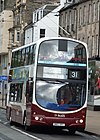Related Research Articles

Warwick Avenue is a London Underground station in Little Venice in the City of Westminster in northwest London. The station is on the Bakerloo line, between Paddington and Maida Vale stations, and is in Travelcard Zone 2.

Kensington (Olympia) is a combined rail and tube station in Kensington, on the edge of Central London. Services are provided by London Overground, who manage the station, along with Southern and London Underground. It is in Travelcard Zone 2. On the Underground it is the terminus of a short District line branch from Earl's Court, originally built as part of the Middle Circle. On the main-line railway it is on the West London Line from Clapham Junction to Willesden Junction, by which trains bypass inner London. The station's name is drawn from its location in Kensington and the adjacent Olympia exhibition centre.

Edinburgh Waverley railway station is the principal railway station serving Edinburgh, Scotland. It is the second busiest station in Scotland, after Glasgow Central. It is the northern terminus of the East Coast Main Line, 393 miles 13 chains from London King's Cross, although some trains operated by London North Eastern Railway continue to other Scottish destinations beyond Edinburgh.

Greenford is a London Underground and National Rail station in Greenford, Greater London, and is owned and managed by London Underground. It is the terminus of the National Rail Greenford branch line, 2 miles 40 chains down the line from West Ealing and 9 miles 6 chains measured from London Paddington. On the Central line, it is between Perivale and Northolt stations while on National Rail, the next station to the south on the branch is South Greenford.

Haymarket railway station is the second largest railway station in Edinburgh, Scotland, after Waverley railway station.

Aylesford railway station is on the Medway Valley Line in Kent, England, serving the village of Aylesford. It is 38 miles 74 chains (62.6 km) down the line from London Charing Cross via Strood and is situated between New Hythe and Maidstone Barracks. The station opened on 18 June 1856.

Dunbar railway station serves the town of Dunbar in East Lothian, Scotland. It is located on the East Coast Main Line and is a two platform station. It is 29 miles 5 chains (46.8 km) from Edinburgh Waverley and 364.092 miles (585.950 km) from London King's Cross.
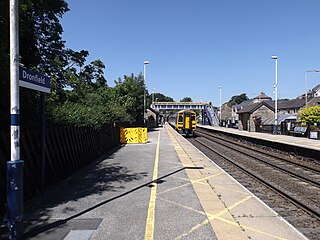
Dronfield railway station serves the town of Dronfield in Derbyshire, England, south of Sheffield, on the Midland Main Line between Chesterfield and Sheffield.
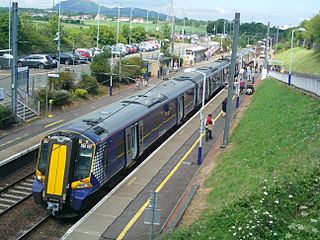
Musselburgh railway station is a railway station serving the town of Musselburgh, East Lothian near Edinburgh in Scotland. It was opened by British Rail in 1988 and is located on the East Coast Main Line, 5+1⁄4 miles (8.4 km) east of Edinburgh Waverley, and is served by the North Berwick Line. It is located near the recently built campus of the Queen Margaret University.

Livingston South railway station is one of two railway stations serving Livingston in West Lothian, Scotland. It is located on the Shotts Line, 14 miles (23 km) west of Edinburgh Waverley on the way to Glasgow Central. It is managed by ScotRail, who provide all train services.
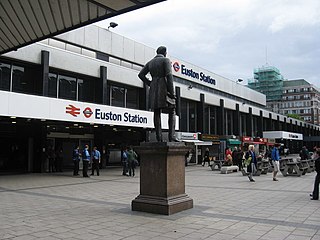
The London station group is a group of 18 railway stations served by the National Rail network in central London. The group contains all 14 terminal stations in central London, either serving major national services or local commuter routes, and 4 other through-stations that are considered terminals for ticketing purposes. All current stations in the group fall within London fare zone 1. A ticket marked "London Terminals" allows travel to any station in the group via any permitted route, as determined by the National Routeing Guide.

Kirkcaldy railway station is a railway station in the town of Kirkcaldy, Fife, Scotland. The station is managed by ScotRail and is on the Fife Circle Line and principal East Coast Main Line, 26 miles (42 km) north east of Edinburgh Waverley. British Transport Police maintain a small office on Platform 1.

Wadsley Bridge railway station was a station in Sheffield, South Yorkshire, England on the Great Central Railway's core route between Manchester and Sheffield.
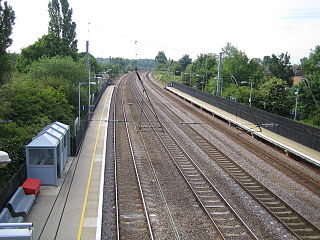
Welham Green railway station serves the village of Welham Green in Hertfordshire, England. It is 15 miles 50 chains (25.1 km) measured from King's Cross on the East Coast Main Line.
In the ticketing system of the British rail network, tickets are normally issued to and from individual stations. In some instances, when there is more than one station in a town or other locality—especially where these are on different routes—it may be desirable for passengers to be able to travel to one station and back from another, or more generally to be able to choose which of the stations they wish to travel to. To accommodate this requirement, British Rail introduced a series of station groups: notional "common locations" to which tickets from stations outside that group would be issued.
The Scheidt & Bachmann Ticket XPress system is a passenger-operated self-service railway ticket issuing system developed and manufactured by the German systems development and production group Scheidt & Bachmann GmbH, based in the city of Mönchengladbach. Since the first trial installations in 2003, seven train operating companies (TOCs) in Great Britain have adopted the system as their main passenger-operated ticket vending method, while four others have installed machines at certain stations on their networks. More than 1,500 machines are in place across the country, and more than 850 stations have one or more. Machines can accept cash and/or payment cards and can sell most National Rail tickets.
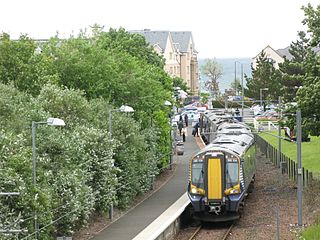
The North Berwick Branch is a short railway branch line built by the North British Railway to connect North Berwick, in East Lothian, Scotland to the East Coast Main Line. It was built as a tactical means of excluding competitors from the area, and when it opened in 1850 it was loss making. The later development of North Berwick as a resort and a golfing centre transformed the branch line.
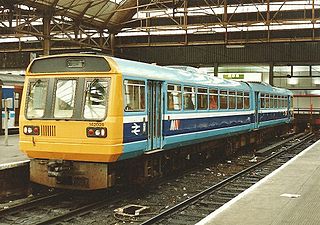
Network NorthWest was a brand name of British Rail which was applied for a short period to the provincial railway network in North West England. It was launched in 1989 during British Rail's sectorisation programme which created distinct brand identities for regional sub-divisions.

In 2014, a new design was introduced for train tickets issued on the National Rail network in Great Britain. The pre-2014 design was similar to the APTIS design introduced in 1986 by British Rail.

A SailRail ticket is one that allows someone to travel using a combination of train and ferry as a single purchase. The brand, which was in existence by 2005, is principally associated with rail tickets between National Rail stations in Great Britain and stations on the Island of Ireland, including ferry travel on one of three routes across the Irish Sea.
References
- ↑ "British Rail News: New and Re-opened Stations". Journal of the Transport Ticket Society. Luton: Transport Ticket Society (273): 385. September 1986. ISSN 0144-347X.
- ↑ Holder, Geoff (2013). The Little Book of Edinburgh. History Press. ISBN 9780752492964.
- ↑ "British Rail News: New and Re-opened Stations". Journal of the Transport Ticket Society. Luton: Transport Ticket Society (273): 384–385. September 1986. ISSN 0144-347X.
- ↑ "British Rail News: New and Re-opened Stations". Journal of the Transport Ticket Society. Luton: Transport Ticket Society (272): 343. August 1986. ISSN 0144-347X.
